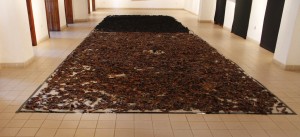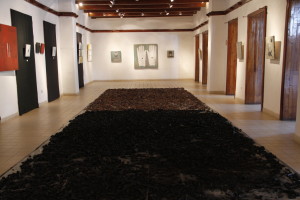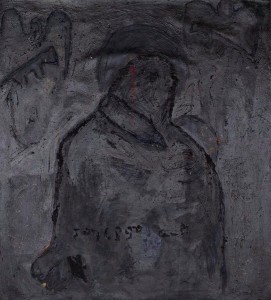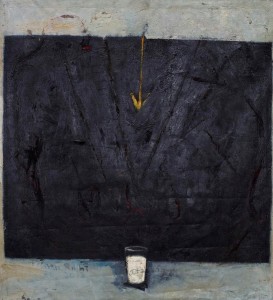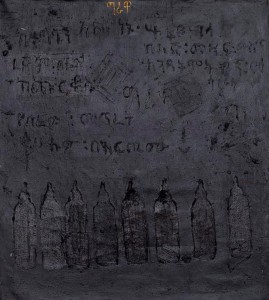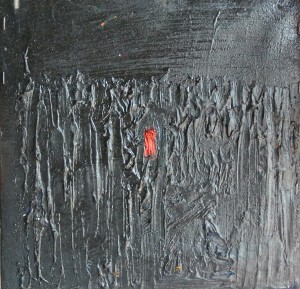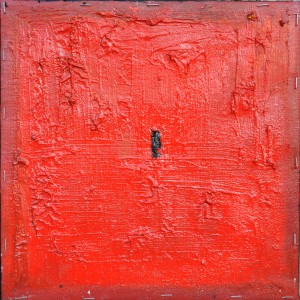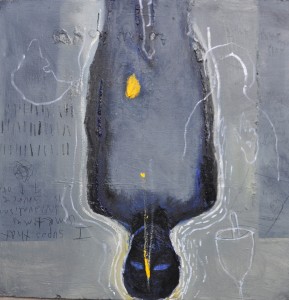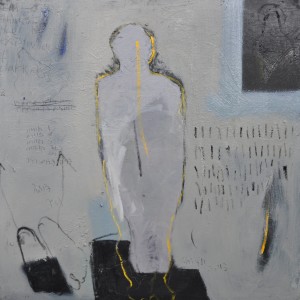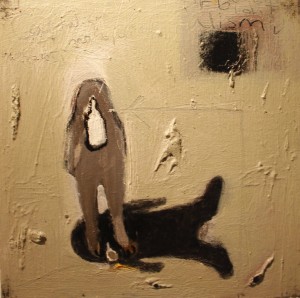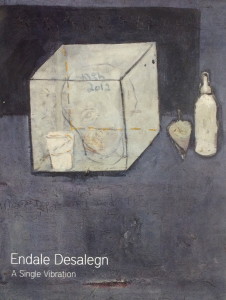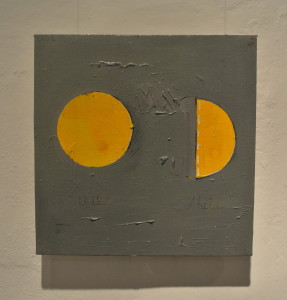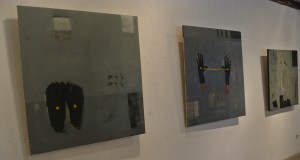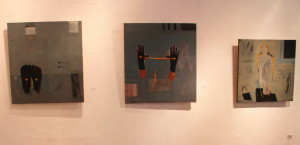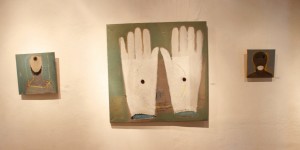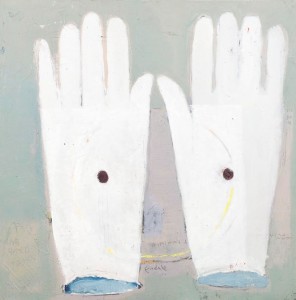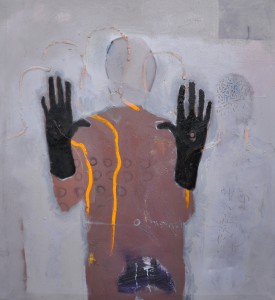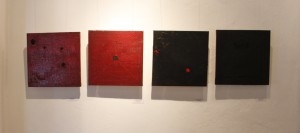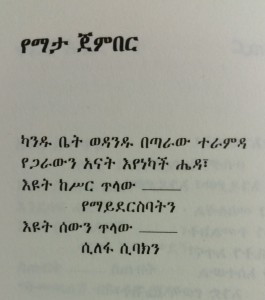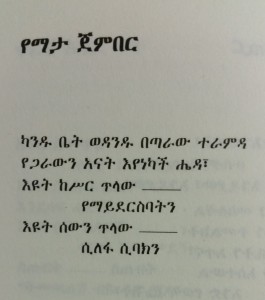
Sunset
Strolling from one to the other housetop,
Rambling to stroke the mount’s cap.
See the shade, beneath,
where it can’t ……..
stretch itself, long enough.
See man’s shadow track …….
broken rough, emptied and lethargic.
Mulegeta Tafese on the Ethiopian artist Endale.
Medium that Thrives to Live (BirrDerra Berbere Siit)
Beneath the Red and the Black Pigment’s Shade (1)
Dusking Gold(2)
It seems we know each other,
you, nightfall’s rash blink,
blooming flare,
raging spark,
horizon of Athena’s crags – golden dusk,
Far-flung are your rays,
your nocturnal firework
your radiances.
Ahead looms your upcoming bud,
a high-pitched yellow mélange
amid ruddy colors, clouted,
by the airport’s fringe
the transit: – is dispersed,
a tour to resume the tour
what I say now, is now prompted,
the craft is about to swirl,
move, and start its glory sped.
Piquant and bitter: Endale’s visual imagination or his telltale blabber– an enunciation?
A cooking ingredient gets its piquancy while getting prepared right on the spot in the thick bowl, reddish black ceramic pot, in order to create, originate, initiate, and cause the water mouthing spice to unearth its magic – a delightful transformation, to make a first-rate stew and preserve also a suitably great savory delectation to the diner. This way, the anticipated taste would arrive to its full circle, when it rewards delicious nourishment to the voraciously starving. Justly deep to the sense of organs, not by any means insincere, but natural, the hot savor is gotten when it comes close to the nose pricking, and mouth salivating stage. Inevitable chemistry. The estuary, the live throat entrenched within, as body interior passage, doesn’t belie the stomach to an exit for savor and nutrition that money can buy.
Dusk tanned red herb or sundried pepper spreads allover, not this time on the pots and pans, but on the old mahogany floor representing a piquant Zigny stew – Habesha spicy woot, food components (overall Ethiopian flavored dish) that Birr can buy. But spare the disenchanted social media poet who writes in Amharic, Birr anymore can’t buy Berbere, with which one cooks a steamy hot sauce. Is this only a talk of food? Or the praxis, an application come true in a pepper powder heap and its kiln, which keeps the burning charcoal, keseel that cooks it alive, so to speak, Agbo, (a bitter joke) the Ethiopian conversation art where you can critically shoot at your aims – striking more than two connotations at a time. The meaning is often hidden – under. Word nuances coated with covert language. Not a silly consent, if you think like me!
Those who don’t contend with the meaning soon would be trampled – wooed at, and would give up. Hence, the turn arrives to the other door to enlighten reciters, what has brought the new day, and, what’s meaning after all, or like the unfinished chess game the contested will plead time. Definitely, s/he’ll have it, but here is how the rousing thing occurs, when the Agbo (concealed language, Amharic) is dissolved into sense and significance. This meaning-thick semantic then ceases to play itself in order to craft verses and create art. How do otherwise artists’ mediums, which heavily texture the content and form of their oeuvres voice to make themselves be visible? Helping artists to expeditiously produce artworks, what is the underlying topic looming big? What are these artists’ mediums – narrow or large-scale, tiny creativity threads, big issue series and in succession running work procedures? And what are the predicaments of artists’ work ethics, long or short-lived toils? How are these artists engaged in their subjects’ inner compass or interiority?(3)
Endale, a resident of Addis but an international artist on the making, seem to respond to these questions, albeit in silence, as he presupposes key elements in his art making, which emanate, one ponders, from a dense and dull stalker, caught possibly by a randomly discovered aesthetic marker that explores the interiority or the inner confines of his painting binder. Social language.
Image 1. Installation.
Image 2. Installation. The two photos reverse eachother’s foregrounding, respectively pepper and charcoal, approximately 14 x 6 meters; Medium – dry pepper, charcoal, metal objects, textile piece carpeted for the installation, masking tape, dimension variable. ‘BirrDerra’, ‘Siit Berbere’ (Amharic, title of work, respectively translates to ‘it sells well!’ sundried Berbere’), is the Ethiopian cooking ingredient on display.
Endale’s Geez (4) penning and vast painting pats pleading YeMaryam Menged (5), i.e., try the doorways for vocal choruses and silent prayers, and blabbers not leaving out the primordial social system or/and the capitalist condition. This is real, and doesn’t threaten any one unlike the subtheme of my text stated beneath somewhat surmising a different claim.
Revealing riddles from the painter’s palette: Savor the piquancy! Smell the air!
How could the artist connect himself to the public and nourish the later with a perpetual thought, a curious teaser, a model ploy, or a word and a line, when he, as an artist has a passionate need to create one. A silent song to himself, art has an agent of a pacifier, a concession that the artist would make with the public, as I’ll try to define shortly. We will focus now upon artists’ nourishing act – their educating and cultivating roles. It is our modern day adagio however, we happen to listen this intermittently: High moral serves the public. And the last has some enlightening roles to play like a baby suckling Tu-to.(6)
“The new body of work is a profound meditation on the ways we perceive every day objects in the lights of the social structures that dictate how we relate to the world (…) He calls on metaphorical visual tropes, such as a baby’s milk bottle and a pacifier, to draw connections between natural and constructed systems of social dependence. Where the milk bottle stands for the adult’s relationship to an ATM, the pacifier evokes methods of compensation used to sooth unfulfilled desires”
The infant will be detached of the Tu-to when he grows up, may be, by the memory of the horrible succor of Grawa leaves (7) (bitter leaf, Amharic). One day he would recognize that Tu-to is a fake object and has to stop. I speak about the Tu-To that is a substitute to the milk bottle – the Tu-to that deprives reality.
Image 3. YeMaryam Menged. The Darkness/ Milk. II […..]
Image 4. Pic d, Milk darkness I, 80 x 90 cm, oil on canvas, 2012
Image 5. Grawa (inscription in yellow, title – Amharic), 80 x 90 cm, oil on canvas, 2012
The painter’s medium is irresistibly useful a device, like the Tu-to to the infant, while Tu-to, oftentimes is unreal in its physical state, like the fisherman’s light and elegantly woven net cross-stitched in perfect squares, makes the fishing or the catching miracle. In equal measure, the carpenter’s repetitive saw indentations, precisely forked blades designed to slash a chunk of wood, slash a chunk of wood, like nothing and in no time. The same is true with the poet’s realistically inexistent but smashing influence or his towering edifice, bar not, the gracefully flowing verses, the mediums, all are but sacrosanct items to the Creator, the users and identifier, therefore very useful like the faux-pas nurturer Tu-to (8). The last is dubbed in Ethiopia as YeEnjera Lij, ‘step mother’ in the Amharic semantic. Endale’s aided by his symbolic and metaphorical strategy, criticizes both the socialist and capitalist social systems that he knows best. His works’ parodies are well-defined in the “social pacifiers” context, Chris Turmans, contends (9):
“Endale’s work is influenced by the rich culture of his home country, in which a strong sense of mythology is layered with everyday experience, i.e., the milk bird features as a symbolic presence in most children’s lives. The belief is that when ones’ milk teeth have fallen out, the teeth are collected by the bird and carried away, leaving room for growth, into maturity. The bird has come to represent a shift into adulthood”
Thinking about Endale’s art alongside the prior citation of valued household items in mind, including the unkind nurturer that feeds the child nothing, but only air, Tu-to is a powerful disguise, as in literature, also in living popular anecdotes and in other knowledge edicts that Endale uses to enrich his art. One has also to investigate hard and practice further to produce art with these agents and devices. These collective cultural displays are open repositories to the artist to use, and, let’s hope that they would never become an absorbing artistic and analytic harangue where no one could determine a worthy outcome.
Subsequently let me embark on a minimalist tic, reading from the lines of one of our modernist poets, Seifu Metaferia Frew. The annotated poem beneath the title, Dusking Gold (10), takes a black and red lining. It moves also with the concept as black and white, European opposing binaries and it is a symbolic fusion, dualism of, well, a trodden sky and land, a near-abstract adoption, to my mind, Endale Dessalegne’s pictorial realm, thus.
One of the few but surely the most important appreciators of Endale’s art are the IFAS (French Institute of South Africa) director, Denis Charles Courdent and the diplomats Vera Fernandes and Hector Valezzi who saw great prospects in Endale’s art as they continued to follow his development as an artist in Addis Ababa. Endale showing his paintings with South African artists in a group show at the Kauru African Contemporary Art Exhibition at Unisa Art Gallery, Pretoria, says something very pertinent about the onset of his international career. This is likewise the news that delights an Ethiopian art public to hear. David Krut Projects hosting Endale’s individual exhibition both in 2014 and 2015 in South Africa certainly reflects on this story. And the story says about Endale’s participation in the group exhibition indicating that it was to facilitate a change of perceptions about the continent through its contemporary art. Endale’s involvement through dialogue with twenty other artists from South African Development Community (SADC) and East African Countries greatly impressed his audience, David Krut projects discloses (11).
Image 6. Center of Interest II, Berbere (Pepper) 30 x 30 cm, oil on canvas, 2014
Image 7. Center of Interest I, Keseel (Charcoal) 30 x 30 cm, oil on canvas, 2014
So let’s assume now further Endale’s body of art presented at the Addis Alliance in 2015 that ostensibly invites a critique, as his art is set consciously on purpose, on the given space and floor; hence, suitable a venue to give a spark (of reason), to reinstate new things to evolve, and original ideas to regenerate. The nature of his research-based penchant needs that. Endale’s food culture items that he uses as his brilliant wedges for creating art are his urban semantic. They are his deep dives to bring and use in his art, an inducement to fire his artistic intellect. His works, presented exceptionally well can’t afford a neutral meaning; moreover with some kind of ease, the young artist shows an articulate social value that impacts his painting supports. His material art framework; from his serially displayed – put in pairs, in troikas, in foursomes paintings – to 2D or II dimensional art work, and to a macabre idea of imploring installation art, no body in Addis agrees to, and in general, his exhibition settings are both a delightful aesthetic medium research and a food-savoring tale – a big time blend – an experience.
Endale’s oil painting concretely savors the black minimalist aesthetics (that seem retaining the modernist followings) and it’s never out of content – it has a language veneer and its pretext beneath – paintings and installation art. His art has a cunning edge to it, involving the vital Ethiopian cooking genera, the spicy hot pepper – Berbere (12). The charcoal (13) – a crucial kitchen utensil for ‘Ethiopian slow cooking’ – is also there to match Endale’s installation to genially steam and grill his cuisine. The last is truly entrancing an expression, food for thought and body. And this fulfills a traveller’s first-rate pack for any thing that s/he can use to exit out from the labyrinth path through Endale’s discovery – YeMaryam Menged (14).
What are the contextual underpinnings of capital to Endale? Is it a mere Ethiopian element, commodity, or an agrarian produce and merchandise traded and exchanged locally and globally? Here, I’ve mined into Ethiopia’s semantic and its linguists’ annexation of the term capital, trade, and economy, which respectively translate to Nway, Nigd, MTanee Habt. The later three italicized terms have their own etymologies that relate them with the former three. From Baykedagn Gebre Hiwot, to Kidane-Wold Kifle, Amsalu Akilu, Berhanou Abebe’s, respectively, the later four’s economic, linguistic and historicist notions, their capital’s understanding is similar with the western understanding. Even the etymology of Capital, (Nway), and Money (Genzeb) are reviewed in the books of the previous authors soundly. Capital derives according the linguist Kidane-Wold Kifle from to note, notice, (TeGenezebe), s/he is reminded, or rewarded money, wealth or coins (15).
One wouldn’t stay long to notice the bank note, the certificated or legalized sum of money that represents a growing or a devalued Capital. Berbere, there fore is considered, as a rare expensive cuisine item, and was once considered as Money – a great currency. Sure in some European languages including in Dutch, to signify an expensive item, people might hint a pun about it, with the adjectival remark “Peperduur”! To return to the Capital figures of Endale the firewood charcoal and crushed pepper, are they warring items in a complementary colors’ disguise or he has another underpinning about it all, relating his stories with, say, a post colonial rationale?
Image 8. Albonet I, (Nothingness) 100 x 100 cm, Oil on canvas, 2012
What are the young painter’s ‘objecthoods’ and ‘agilities’ expressed in his comprehensive artistic gears, from conventional painting mediums to kitchen ingredients, are they i.e., Africa’s social histories’ subjects – his political cross-reference?(16)
“Sealed into that crushing objecthood, I turned beseechingly to others. The attention was a liberation running over my body suddenly abraded into non-being, endowing me once more with an agility that I had thought lost, and by taking me out of the world, restoring me to it […]”
Addis is a historic spirit laden with several layers of histories. Full fresh and old stuff stuck together; subjects that brave to animate the good and bad, which both regularly regenerate. The one, we want to hear and herald about, to catch an awesome sight of, and the other, we implore to disregard and haste to bury it beneath the rocks by closing our eyes and stripping bare our minds. And here we stand looking at our regained pose, the old pieces anew bound, and the fragments that have been put together as Fanon states (17).
“ […] But just as I reached the other side, I stumbled, and movements, the attitudes, the glances of the other fixed me there, in the sense in which, a chemical solution is fixed by a dye, I was indignant; I demanded an explanation. Nothing happened. I burst apart. Now the fragments have been, put together again by another self.”
Image 9. Albonet II (Nothingness), 110 x 100, oil on canvas, 2013
On this foundation stands the memory laden art oeuvre of Ethiopian artists; novelists like Bealu Girma and Sebhat Gebre Egziabher, painters and poets like Agegnehu Engida, Gebre Kristos Desta and Mesfin Habte Wold, poets and dramaturges like Tsegaye Gebre Medhin and Mengistu Lemma, to mention just a few (18). Endale’s patois however youthful is not separate to the prior group, as he uses similar historic and linguistic concepts and inspiration models. However he concentrates on his own stories focusing at his own Addis neighborhood humbler quarters, aiming at his personal researches. His resolve particularly zooms towards the center of Addis, specifically, if I recall well my discussions with him in April 2015, to the Cherkos region where one of the most deprived urbanites lives.
Cherkos if not outright a comparable district to Merkato, it certainly is intangibly similar with the last. Tsegaye Gebre Medhin, Ethiopia’s poet laureate and dramaturge once has immortalized with his sharp lyrical genius and bold pen Merkato, Addis’ titanic open market. “Ai Merkato”, Tsegaye’s poem surfaces at Addis’ never sleeping vendors and their perplexed customers’ situations, amid the topographic picture of this exhaustively visited market place. Yet Merkato remains always odd as it exceedingly bargains its’ matchlessness as a market place in African societies. Tsegaye left us the mundane social landscape, the perplexing reality, the beauty of a place, the running and static time. Merkato stuck with its past and exceedingly fluid actions and human capital, catches the fringes of the affluent and poor natives’ curiosities – the confusing and orderly state mono reference.
Approving the Lower Social Register: III World Urbane as Artists’ Superb Hub
Addis’ Cherkos, in magnitude parlance is second major marketplace place after Merkato, and there is a name for the later, arguably Africa’s biggest open market. In all its gauziness and haziness, obscurity and muddle, fixed and fluid capital, thus, Merkato remains to be the biggest that tickle the trading vestiges of the human soul. Cherkos, or the Kirkos sub region, a cluster of poor neighborhood surrounding a market area and a famous church St. Kirkos, is a famous location in Addis (19).
Image 10. Morality and morbidity, 40 x 40, oil on canvas, 2014
The painters Gebre Kristos Desta, Tadesse Mesfin and Eshetu Tiruneh have opened about forty years ago their populace’s mind to realize how impoverished the wretched Addis neighborhoods are. The last seem to duplicate the porticoes of Ethiopia’s destituteness, and its rocky massifs that don’t green always. The art of these artists that incorporate also theater stage designs, and posters without any pretenses and masquerades has manifested the despair of generations. These artists have shown in their paintings and theatre stages, in fair honesty, a down town Merkato neighborhood, Ye Chiid Terra and the Old Qerra’s fringes, Fit Ber also called Filwoha, the distressing misery loopholes of 3rd world cities are all there in the Ethiopian Modern/Contemporary art repertory.
These are ghetto settlements or rejected underworlds any one curse. One might evoke also at this time the old picture, which the prior artists and poets have portrayed from its many angles. Especially today after the aftermath of East Africa’s youth tragedy, life and death fight, bleak destiny as the lives of immigrants in the Middle East, Northern Africa, Eastern Africa, Southern Africa countries and the coast of South Europe show us, the suffering of humanity lingers. These artists have deeply examined their subjects as the French realist and realist grandees; Gericault and Courbet once have successfully mirrored the social indictments of their societies augmenting it in a poetical poise and true sense.
One can judge now the “Siit”, Endale’s Berbere and Keseel parody – pepper and charcoal tinged story – in the tacitly spoken Cherkos neighborhoods’ alleys and rooftops, how pricey and valued it could be. The “Siit”, (open laid, exposed, Amharic) could be seen as Endale’s well-timed subject matter, one can deduce, some human souls exposed to toil and trouble in the world. Siit is not a human adventure; it’s its paucity, an inactivity of doing nothing. One also construes, the tragedy of his contemporaries – Ethiopians, East Africans, and world citizens – is interminable. His contemporaries’ sagas tell saddening stories, all in general who are running to escape war, poverty, or both, altogether abominable offenses. Engulfed with one of the greatest world immigration, these tragedies are acute markers of world history at the present stage. Now, it’s also fault to suggest Endale’s art vocally addresses the socio-political problems of his society, in a nub, like a publicist does in his rubric. That is nonsense, and not an issue here, as his art doesn’t discuss these narratives, as his research in art is focused on an exceptionally minimal and highly individual style, although he has slightly snatched off-track popular jargons to mix them in his sober painting vernacular.
That is true, “Siit” laid to be sundried has a socio-cultural connotation laid to it, supplemented with some numinous sharp objects that are not sorcerous, as they’re there only to scare away the prying evil eye. Zealous bad spirits that are tormenting the world must be scared away by sharp knives! Metals as powerful objects, Cherkos’ social beliefs have it, leave their shadows on the Berbere. The spice, by association, with the shadow of the metal object is effectively protected from a bad omen. The hot peeper is a famous staple food ingredient for Ethiopians, a life vessel or almost a supernatural medium, in Endale’ case, that thrives to live, beneath the lines of its physical forms, in the Red and Black shades (20).
The scent of the smokes that come out of the cafeterias and bistros, the dust and carbon smoldered junipers that deck compounds, and the slightly tilting beige houses with iron fences, which shades have faded away by time and the never closed, but sidelined small businesses are never out of sight and out of enunciation. In fact, they are all genuine items that we always try to enrich our viewpoints with whenever we stare Addis’ old vicinities; be it Piazza or Cherkos, respectively Endale’s Addis pastimes and domestic environs. These are places for the free born, however they might be poor people’s alleys, tenaciously developed and improved with their unique escape routes – YeMaryam Menged (21)as they in their vacillating occupations welcome us to the family home.
Here we draw a resemblance with Endale’s Grawa medicinal plant, which he painted it as black, although it is not juniper for which it looks as such from far away. Endale with his in Geez inscribed alphabet sustains the indictment that these medicinal Ethiopian “vegetal bushes”, bitter leaves’ saps hard pressed together with their white crème flowers, are used by Ethiopian mothers to help them stop breastfeeding by smearing it on their nipples to thwart their infants from milk suckling. In Ethiopia infants suckle their mother’s milk until they are four year old, just before they leave for preschool. Now with the urban mothers employed, children may stop suckling their mums’ milk much earlier, and they will get the powder milk substitutes of Guigoz nestle milk, and other types that the market supplies. The plastic milk bottle, or its surrogate rubber teats are handy in this regard. The Tu-to pacifier thus is Endale’s subject of his 2015 South Africa show, a go-between proxy, which is an infant’s manifest substitute of its mother’s milk (22).
Image 11. Exhibition poster, A Single Vibration, David Krut project, 2014
To come back to Endale’s second show at Alliance that I’ve attended in April 2015, I like to quote the Reporter’s art columnist. She says, Endale speaks about an art public that he is interested to know what they think about his art. The journalist was alarmed about the use of his techniques and his widespread black and white palettes. She writes, ‘Endale says, for him the obscurity is not the lack of light. It is a way more than this, a thing by itself and a part of reality (23). The darkness is where our imagination starts to kick in and mixes with the reality. (…)’ The columnist highlights further, on his oeuvre:
“His paintings could almost pass for moldings, rich and composed multiple layers, that are stretching out of the canvass inviting the bystander into the Artist’s world and thoughts.” (….) “Behind the peaceful gray that dominates on most of the creations, some blasts of colors are incensing the mind. There is nothing obvious; everything is standing in the details and the abstract.”
Endale vastly readied monochromes, as Reporter’s art columnist rightly has noted of his grays, could be considered as abstract paintings from the onset, but they visually also cover some enthralling stories, albeit in a rapid heavily paint laid brushstrokes depicting his story tiers. As his excellently laid painterly markings as aesthetic signs impregnated by textual and visual meaning, no wonder his visual patterns allude to the Addis tales and down town chatters. Therefore his art convincingly settles his acute social account in a realistic and expressionist gesture. His pictorial technique doesn’t leave out the meaning laden ‘world-class art’ and Ethiopian rich painting tradition, ancient to modern. In this way, Endale clears out himself from the abstract art veneer of Malevich just to explore some new art forms. As his painting fully implores with YeMaryam Menged, i.e., the archetypal use of Ethiopian psaltery art exploiting it to his own end uses.
Endale seems to be preoccupied by the prayers of Ethiopian orthodoxy and by its symbolism connected to the body, nqinaqe, Akwakwam (read the last two italics, respectively as body movement, and stature, Amharic) of the Church devotee, or the street vendor who is also in God’s name an alms seeker. The hands of these devotees, their palms, their feet, and the signs of the prayers that is sought after and performed, seem to be frozen in Endale’s painting cadences and tonal modulations; be it by arrow signs, circles and semicircles, as he calls for, i.e. one of his paintings, “Circle and ½”. (Image 13) All painted as points, stripes and lines tell of a spatial intonation – a step away to make a figuration ascertainment. He inquires on the flat surface representing an ideal truth. He says his paintings, i.e., YeMaryam Menged series are all about a form of meditation associated to church prayers. He explains he wants to show the relationship between body and spirit thus according the time of devout chants – spiritual observances and invocations. He seems to be caught by a sense of portraying his country’s ancient spiritual tradition as he renders in his expressive individual style that use multi media techniques. Hence he uses his paintings as vanguard of tradition, the spiritual world of his ancestors.
Endale’s art uses letter symbols from the Ethiopic alphabet repositories and also the Amharic language, an East Africa lingua franca and the national language that all Ethiopians communicate with. He often minimally transcribes with Geez letters on his painting surface in the sharpest way possible. His transcription could only be two trivial signs, only two Geez letters, “Tu-to” and in this way he turns to realistic and representational interpretations and generalities. In this way he flattens the art of figuration when he use graphic markings but to sequester it later by blowing it in a spatial renderings. This is in a brief way what his art looks like, and that is also what I can think of his art is all about. Not a small conundrum to explain. A contest between lessening realism and swelling passion and spiritualism, he struggles to substantiate his art.
Image 12. Exhibition overview, Endale, painting, Installation – textile, Masking tape, pepper, charcoal, 2015
Using a diverse source of materials, Endale is a trained painter whose aesthetic penchants and parodies lend elements from the Ethiopian visual art repertory, in particular from the Ethiopian church paintings. He doesn’t disregard Ethiopian church iconography and its modern progeny, the Ethiopian modern painting. Likewise he uses a large ensemble of visual art to a very purposeful effect. I’ve not visited his first solo show in Addis, but I’ve been following his activities through e-mails as I luckily have established great contacts with most Ethiopian artists.
Hide and Seek, an alteration route to YeMaryam Menged?
His entire installation work in 2015 particularly the “Berbere Seet” in the Addis’ Alliance Ethio-Française Cultural Center stood out extraordinarily well. The Ethiopian saliva emitting spice, Berbere, a very popular Ethiopian ancient cooking ingredient was Endale’s main subject. Berbere, a strong cooking ingredient is now in the eatery world fresh and anecdotal as internationally it epitomizes the Ethiopian cuisine. Endale has an original case in point at the Alliance Addis to brusquely display his culinary on the central gallery floor. As a strong not nominal symbol and item – an imploration, if you want, a prayer sign to God, stressing metaphorically the Ethiopian religious prayers, BeEnte Mariam, Endale’s metaphor to certain food items and medicines is boundless.
Mary, help me, and rinse my sin! The aisle, at Alliance Ethio-Française, situated between the restaurant and the new edifice that I’ve explained above is actually stands intact for a long time. (See, picture above, Image 15) Endale’s installation, 16 meters long, almost stretching the whole Alliance central gallery’s space runs along the two parallel isles of the Alliance’s oldest building. The installation superbly filled the physical scale there and the mental crux was not concealed neither. It is enough only one to remark in words about a handful spicy hot Berbere crop (24) that raptly fills everybody’s mouth and nostril. The prayers, in the piquant plea are etched and painted into the painting surface with Geez alphabets that enclose the red and black shaded installation. ‘Red’ and ‘black’ Geez letters as in the parchments of the scribes, equivalents of ‘black’ and ‘white’ are there for real.
You may sneeze as an onlooker viewing also his equally piquantly anecdotes. In both east and west side, far apart flung, but facing each other’s large walls, there are six displayed paintings. These are portraits that treat their subjects semi-abstractly. In the east side, the large canvas of the middle signals two open hands – perhaps in a religious gesture saying prayers as Endale’s YeMaryam Menged (25) painting titles suggest – which emerge from a flimsy gray background. These open hands, part of his YeMaryam Menged series, (Images, 14, 15, 16, 17) what could they be, if they weren’t the Creator’s Hand that channel faith and immortality to His Conception – Earth and other living things being His Creation. Endale observes with these paintings assembly of the Ethiopian belief system many things.
The two extended sidewalls, which keep also the adjoining 8 or 10 doorways between them, reserve also smaller paintings that reflect the sanities of his installations. The adjoining entrances take us to the newly restored restaurant and to the other naturally well-lit gallery that walks us to the front gate of the gallery. Endale has hang in the later two of his largest paintings that keep the same title – YeMaryam Menged I, and II (26). (Image 3) Hanging at the adjoining central walls small paintings, two red next to two black canvases, the artist utters some words in silence. His works are set along at a place where the difference of minimal and abstract art is if not marred but sidetracked or blurred. Visual language nuances are thinly and vaguely laid upon each other giving a determent. These paintings remind us of the Russian avant-garde painters.
Image 13. Kiib ena Gimash (Circle and Half), oil on canvas, 40×40 cm
Endale’s paintings, as we see above in (images 5, 8 and 9) first and foremost, like the renowned painters from his country intensely fasten the qualities of both free and loose allures of Geez calligraphy. Eastern calligraphy is not far behind nor is it left as too a remote practice. To Endale and other modern African painters, their revered senior masters like Obiora Udechekwu of Nigeria; Ibrahim Salahi, Hassan Musa and Rashid Diab of Sudan; Gebre Kristos Desta, Skunder Boghossian, Wosene Kosrof and Tadesse Mesfin, of Ethiopia who use from their respectively popular visual cultures’ mines; Uli, Arabic, and Geez graphic and expression forms, there is yet unrevealed breakthroughs to be wrested readied. Afewerk Tekle, the great Ethiopian painter and cultural highbrow until his death confessed that his tomorrow would better succeed in art than now (today), while his rival Gebre Kristos espoused the unreserved trance, in his poem “this travel never ends”. He meant travel, painting. They both meant to stand by the art side until their last breath, and, no surprise, they did!
The place where Endale has studied in Ethiopia, the Alle School of Art and Design has added international influence through its teachers’ diverse experiences. Thus for students, although it isn’t an easy jump to be artists, after they finished school, but they get an adequate higher education. Endale’s works that amass light to dark grays, from drab beige to leaden black strike accord either by mere coincidence or through advanced education and deep enquiries with Eastern calligraphy, in a fast and efficient manner, filling the painting surface like real painters gratify sating the canvas’ blank opus. A painting surface that reminds us a wide nest of a world art experience, most notably of the American Ab-Expressionism, also other African schools. Endale tries to converse like his contemporaries in the art world do; be it with American abstract expressionists’ modern art metaphors, visual languages, and self-expressions. And he is equally in constant dialogue with the Russian avant-gardists’ groundbreaking art, and other visual culture manifestations, which is of a paramount importance to hold things up in a rock-solid simplicity. That is a lifetime errand, and he’s busy with it.
Image 14, 15. Above and down, both photos address the same wall of Endale’s exhibition at the Alliance’s salon, 2015
Endale’s black spots, moon shaped props; faces without eyes and mouth that don’t stare at any one, as if they are the mystical nimbuses that interfere in people’s daily businesses, or they mind only theirs. Whether these devotes’ sight and speech is detached from them, we don’t know, what we know is, these figures’ manifestation, in spite of their appearance, are redundant as their actions, is dissolved in silence and nothingness (look Image 9). As one of Endale’s painting titles, reads Albonet, (nothingness, Amharic), we’re not sure, whether it is aimed at the famous 20th century philosophy’s diction (i.e., Sartre’s Existentialism or Humanism with the grains of Husserl’s phenomenology?). However of the prior observation about Endale’s large paintings, hanging in the old central hall of Addis Alliance Ethio-Française, hold albeit in tiny hidden forms, they do construe two small signals for portraiture for the two small adjacently hung pieces. (Look image 16, beneath)
Image 16. Pretender-II, Portraits I II III with Yellow and Black Circles.
The two middle pieces (image 16 and 17) open white palm hands that look like a pair white glove with two red spots in the middle of the wall emphasizes Endale’s YeMaryam Menged painting series (Images, 5, 18, 19) that Ethiopians praise and seek advice from. The Mother of God has this generosity in plenty. There is a prayer for Mary, the Christian devotees repeatedly say. It is this special prayer in the name of the Mother of God, through Her pitying, one asks guidance to the right passage (Heaven), YeMaryam Menged, Endale has discreetly adopted this motif in his works. Who doesn’t need a consolation from Mary, Ethiopians reckon, in this extremely hopeless and problem heightened time? The two pleading hands to Heaven (or is it a surreal giant air puffed pair of glove, with mysterious jolts, psychic or otherwise bodily?) may not characterize the two large serial pieces marked as YeMaryam Menged 1, and 2 (Images 18, 19), but what is left behind is Endale’s synopsis. Two instants make one! Hence, the spiritual uplifting experience is to be reckoned. What are then these hands if they’re not the Creator’s hand (Image. 14,15) that channel faith and immortality?
Image 17. The Pretenders’ gloves, 110 x 120 cm, oil on canvas, 2013
In the central hall, against the adjoining doors there hang two separate paintings in groups that each consists of four paintings. One group contains two concurrently running red and black canvasses (image 1, 2, 6, 7, 12, 21). A progression in tone and hue is attained. In the second group, a series of medium format paintings, which minimally composed abstract art blending remind us the Russian Avant-garde or other western art styles of the closest genre. Abstract paintings, which piquancy lies on the social critique side, one can say. One can opine also these paintings that are displayed on the wall in mini-groups have the mirror lookalike of Endale’s Ethiopian cooking ingredient installed in a big form on the floor.
Image 18. YeMaryam Menged I, (one is enough to stand) oil on canvas, 140 x 135
Image 19. YeMariam Menged II, (One is enough to stand) oil on canvas, 140 x 135
Image 20. Pretender I, 140 x 140, 2014 oil on canvas
With this I am near to close, but not before using as finale Gebre Kristos Desta’s poem with a divine touch. Sunset, a ballad for an expansive space is an extension to Kristos’ prosaic poem, ‘Give me a Broad way’, or ‘Menged Stugn Sefi’, (Amharic). Kristos’ legendary poem is a plea for ‘free expression’ and ‘postulation’ or ‘Mella’ (elucidation, answer and cure, all in one, Amharic). Gebre Kristos Desta’s nightfall ‘YeMata Jember’ (Amharic, p. 22, last picture) has a brief entrance on the red and black, a contrasting dimness of the end of a day. Gebre’s verse as in a song short interval enunciates the introductory words, Dusking Gold (YaMeshash Worq, title in Amharic, page 1, 1st picture) of Seifu Metaferia Frew. Hence it makes of Endale’s 4-piece quadruple an orderly strip, a closing frieze, and a basic timeout. It sounds like: Good night decent folks, we’re done for today; let’s go to sleep now, tomorrow is another day.
Image 21.
Sunset
Strolling from one to the other housetop,
Rambling to stroke the mount’s cap.
See the shade, beneath,
where it can’t ……..
stretch itself, long enough.
See man’s shadow track …….
broken rough, emptied and lethargic.
///\/\\\///\/\///


